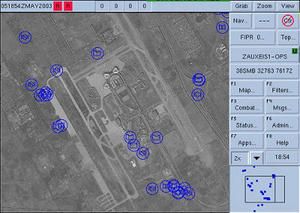State Department to begin tracking its personnel
The U.S. State Department will soon be able to track the movement of its staff as they conduct diplomatic missions in dangerous areas in countries like Pakistan, Iraq, Yemen, and Afghanistan; using the Blue Force Tracker system, the State Department will be able to monitor its personnel’s movements via a small transmitter attached to a vehicle, aircraft, or a person

Blue Force Tracker screen showing assets at Baghdad Airport // Source: msfc.com.au
The U.S. State Department will soon be able to track the movement of its staff as they conduct diplomatic missions in dangerous areas in countries like Pakistan, Iraq, Yemen, and Afghanistan.
Using the Blue Force Tracker system, the State Department will be able to monitor its personnel’s movements via a small transmitter attached to a vehicle, aircraft, or a person. The transmitter sends a continuous signal to a GPS satellite that is monitored at a secure command post. “This critical technology provides department personnel with the confidence to travel into highly dangerous areas, knowing there is an over-watch and a reaction capability to help them at the push of a button,” the State Department wrote in its budget request for fiscal year 2012.
The technology shows the precise location of individuals within ten feet on a map display that changes in real time. According to State Department budget documents, the new system will have “three-dimensional geospatial imagery and the ability to rapidly overlay analytic information onto maps.”
Thermopylae Sciences and Technology (TST), which is building the system’s command centers for the State Department in Iraq under a $23.1 million no-bid contract, says that the system will also allow users to “create and manage intelligence reports or incident reports and easily import and export this information,” which permits “data-driven route analysis, threat assessments, trend analysis and intelligence summaries.” In addition, the Blue Force Tracker will allow command posts to receive one-way messages like distress calls.
The State Department is currently seeking about $9.4 million to support the system in Iraq next year, in addition to the $23.1 million that it has already spent to build four secure structures to house temporary operation centers for Blue Force Tracker. Meanwhile, the department is spending $15 million to build a secure command center at the U.S. embassy in Islamabad, Pakistan.
The State Department has been using the Blue Force Tracker system for nearly six years, but this is the first time that it plans on using it to monitor diplomatic personnel. The system was first implemented to document the activities of security contractors in the wake of the Blackwater scandal in which private security guards from the company were found to have shot several Iraqi civilians.
The State Department views the system as “critical to the life safety of COM [Chief of Mission] personnel by allowing the security officer to monitor their location within three meters [10 feet] and respond to any incident with pinpoint accuracy.”
